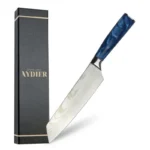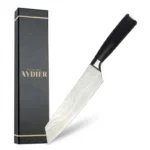Kiritsuke Knives

Kiritsuke Knife: A Traditional Japanese Multipurpose Blade
The Kiritsuke knife is one of the most distinctive blades in Japanese cutlery. Traditionally reserved for head chefs in Japan, it has long been considered a symbol of mastery and precision in the kitchen. Its design blends elements of the Yanagiba (sashimi knife) and the Usuba (vegetable knife), giving it the versatility to handle both delicate fish slicing and fine vegetable work. The long, straight edge with a pointed tip is instantly recognizable and reflects centuries of Japanese craftsmanship.
Design Features and Functionality
A Kiritsuke knife is usually between 7 and 9 inches in length, with a flat profile that encourages clean, straight cuts. Unlike a Western chef’s knife, which often relies on rocking motions, the Kiritsuke is designed for push and pull cutting. This makes it ideal for slicing fish fillets, preparing sashimi, or creating paper-thin vegetable cuts. The pointed tip allows for precise work such as trimming herbs or scoring ingredients.
The blade itself is often forged from high-carbon steel, Damascus steel, or stainless steel. High-carbon steel provides sharpness and edge retention, while stainless steel offers easier maintenance. Damascus steel combines performance with striking layered patterns, making it both practical and visually appealing.
Single Bevel vs Double Bevel
Traditional Kiritsuke knives are single bevel, ground on one side for maximum sharpness and precision. This style demands skill to use and maintain, which is why it was historically reserved for experienced chefs. Modern double bevel versions, however, have become more common and are better suited for home cooks. A double bevel provides balance, easier sharpening, and a gentler learning curve without sacrificing much in terms of performance.
Comparing Kiritsuke to Other Knives
When comparing the Kiritsuke to other Japanese knives such as the Santoku or the standard chef’s knife, the differences become clear. The Santoku is shorter, lighter, and designed for everyday chopping and dicing. The chef’s knife, with its curved edge, favors rocking motions for cutting. The Kiritsuke sits between these, offering precision and versatility with a more professional feel. It is a knife that rewards careful technique, making it especially appealing to cooks who enjoy refining their skills.
Choosing the Right Size
For most home kitchens, a Kiritsuke knife in the 7 to 8 inch range provides the best balance of control and versatility. Smaller sizes may feel easier to handle, but they lose some of the slicing advantage. Larger blades can offer more cutting power but require confidence and space to use effectively. The right choice depends on cooking style, available workspace, and personal comfort.
A Knife of Skill and Tradition
The Kiritsuke knife represents more than just a cutting tool. It carries the history of Japanese culinary tradition, where it was a mark of seniority in the kitchen. Today, it is available in a range of materials and styles, making it accessible to both professionals and home cooks. Whether chosen for precise sashimi slicing, vegetable preparation, or as a versatile multipurpose knife, the Kiritsuke remains a blade that combines heritage, performance, and respect for technique.

